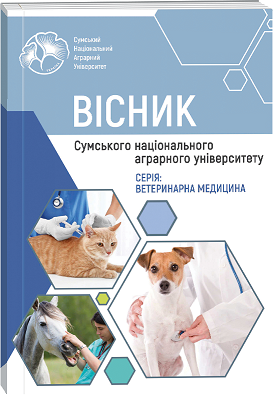ВИКОРИСТАННЯ ДЕЗІНФЕКТОРА ТЕТРАСЕПТ В ОБРОБЦІ КЛІТОК ДЛЯ УТРИМАННЯ КРОЛІВ
Анотація
Дезінфектанти відіграють важливу роль у сфері ветеринарної медицини та тваринництва, забезпечуючи гігієнічне утримання тварин та обладнання. У цій статті наведено результати дослідження, спрямованого на оцінку ефективності дезінфектанту Тетрасепт в обробці клітин, призначених для вмісту кролів. Тетрасепт містить чотири активні речовини з антимікробною та фунгіцидною дією. Дослідження проводилося на кролефермі з 200 кролями. Було створено чотири групи тварин, для трьох з яких застосовувався Тетрасепт у концентраціях 0,1%, 0,25% та 0,5% відповідно, для регулярного очищення клітин, а для іншої, контрольної – традиційні мийні засоби. Результати показали значне зниження рівня мікробного обсіменіння та грибкових інфекцій у групах з використанням Тетрасепту. Також спостерігалося підвищення продуктивності та зниження смертності тварин у цих групах. Таким чином, застосування дезінфектора Тетрасепт є ефективним для покращення санітарного стану клітин та покращення загального стану здоров'я кролів. Мета дослідження полягала у визначенні впливу дезінфектанту Тетрасепт на виживання мікроорганізмів на поверхні клітин та виявлення оптимальної концентрації. Методологія включала бактеріологічний (культуральний) метод дослідження, що полягає у виявленні патогенних мікроорганізмів і кількісну оцінку ефективності дезінфекції. Згідно результатів дезінфектант Тетрасепт виявив значну ефективність зниження кількості мікроорганізмів на поверхні оброблених клітин. Найбільш ефективною концентрацією виявилася 0,5%. Це свідчить про його ефективність, потенціал у поліпшенні гігієнічних умов для кролів та зниження ризику поширення інфекцій у практиці тваринництва. Це дослідження покликане привернути увагу до важливості вибору дезінфектантів у тваринництві, а також надати базу для майбутніх досліджень у галузі гігієнічного утримання кролів.
Посилання
2. Allen, J. L., Doidge, N. P., Bushell, R. N., Browning, G. F., & Marenda, M. S. (2022). Healthcare-associated infections caused by chlorhexidine-tolerant Serratia marcescens carrying a promiscuous IncHI2 multi-drug resistance plasmid in a veterinary hospital. PloS one, 17(3), e0264848. https://doi.org/10.1371/journal.pone.0264848
3. Camacho-Sillero, L., Caballero-Gómez, J., Gómez-Guillamón, F., Martínez-Padilla, A., Agüero, M., Miguel, E. S., Zorrilla, I., Rayas, E., Talavera, V., & García-Bocanegra, I. (2019). Monitoring of the novel rabbit haemorrhagic disease virus type 2 (GI.2) epidemic in European wild rabbits (Oryctolagus cuniculus) in southern Spain, 2013-2017. Veterinary microbiology, 237, 108361. https://doi.org/10.1016/j.vetmic.2019.07.013
4. Chavez-Lindell, T. L., Moncayo, A. L., Vinueza Veloz, M. F., & Odoi, A. (2022). An exploratory assessment of human and animal health concerns of smallholder farmers in rural communities of Chimborazo, Ecuador. PeerJ, 9, e12208. https://doi.org/10.7717/peerj.12208
5. Fukui, T., Niikura, T., Oda, T., Kumabe, Y., Nishiaki, A., Kaigome, R., Ohashi, H., Sasaki, M., Igarashi, T., Oe, K., Hamblin, M. R., & Kuroda, R. (2022). Safety of 222 nm UVC Irradiation to the Surgical Site in a Rabbit Model. Photochemistry and photobiology, 98(6), 1365–1371. https://doi.org/10.1111/php.13620
6. Gleeson, M., & Petritz, O. A. (2020). Emerging Infectious Diseases of Rabbits. The veterinary clinics of North America. Exotic animal practice, 23(2), 249–261. https://doi.org/10.1016/j.cvex.2020.01.008
7. Goins, M., & Hanlon, A. J. (2021). Exotic pets in Ireland: 2. Provision of veterinary services and perspectives of veterinary professionals' on responsible ownership. Irish veterinary journal, 74(1), 13. https://doi.org/10.1186/s13620-021-00191-5
8. Heesterbeek, H., Anderson, R. M., Andreasen, V., Bansal, S., De Angelis, D., Dye, C., Eames, K. T., Edmunds, W. J., Frost, S. D., Funk, S., Hollingsworth, T. D., House, T., Isham, V., Klepac, P., Lessler, J., Lloyd-Smith, J. O., Metcalf, C. J., Mollison, D., Pellis, L., Pulliam, J. R., … Isaac Newton Institute IDD Collaboration (2015). Modeling infectious disease dynamics in the complex landscape of global health. Science (New York, N.Y.), 347(6227), aaa4339. https://doi.org/10.1126/science.aaa4339
9. Kim, Y. J., Kim, J. B., Song, C. S., & Nahm, S. S. (2022). Disinfection of various materials with 3-(trimethoxysilyl)-propyldimethyloctadecyl ammonium chloride in hatchery facilities. Animal bioscience, 35(4), 631–637. https://doi.org/10.5713/ab.21.0302
10. Liu, G., Pilla, G., & Tang, C. M. (2019). Shigella host: Pathogen interactions: Keeping bacteria in the loop. Cellular microbiology, 21(11), e13062. https://doi.org/10.1111/cmi.13062
11. Qiao, J. J., Wang, S. N., Li, J. J., Chen, L. Y., Wang, M. M., Yi, B., Liu, Q. X., Liu, Y. B., Zhang, C., Honess, P., & Gao, C. Q. (2022). Effectiveness of treatment of bedding and feces of laboratory animal with ozone. PloS one, 17(4), e0266223. https://doi.org/10.1371/journal.pone.0266223
12. Shapiro, H. G., Ruder, M. G., Nimlos, N. M., & Pienaar, E. F. (2023). Understanding rabbit owners' willingness to engage in disease prevention behaviors. Preventive veterinary medicine, 219, 106018. https://doi.org/10.1016/j.prevetmed.2023.106018
13. Sousa, V., Mardas, N., Spratt, D., Boniface, D., Dard, M., & Donos, N. (2016). Experimental models for contamination of titanium surfaces and disinfection protocols. Clinical oral implants research, 27(10), 1233–1242. https://doi.org/10.1111/clr.12735
14. Williams, E. S., Yuill, T., Artois, M., Fischer, J., & Haigh, S. A. (2002). Emerging infectious diseases in wildlife. Revue scientifique et technique (International Office of Epizootics), 21(1), 139–157. https://doi.org/10.20506/rst.21.1.1327

 ISSN
ISSN  ISSN
ISSN 



